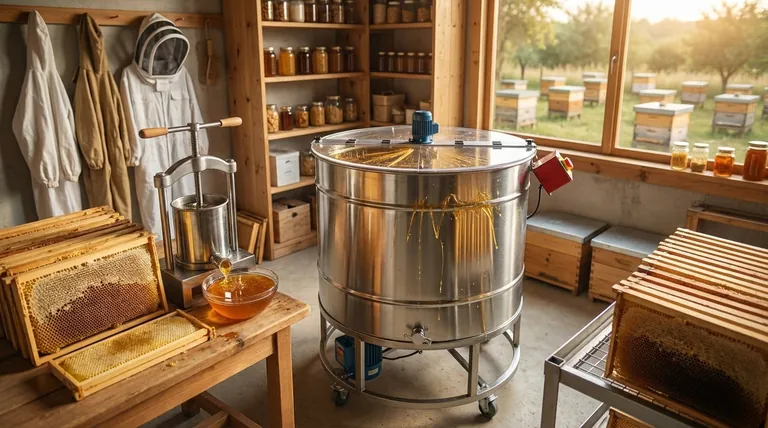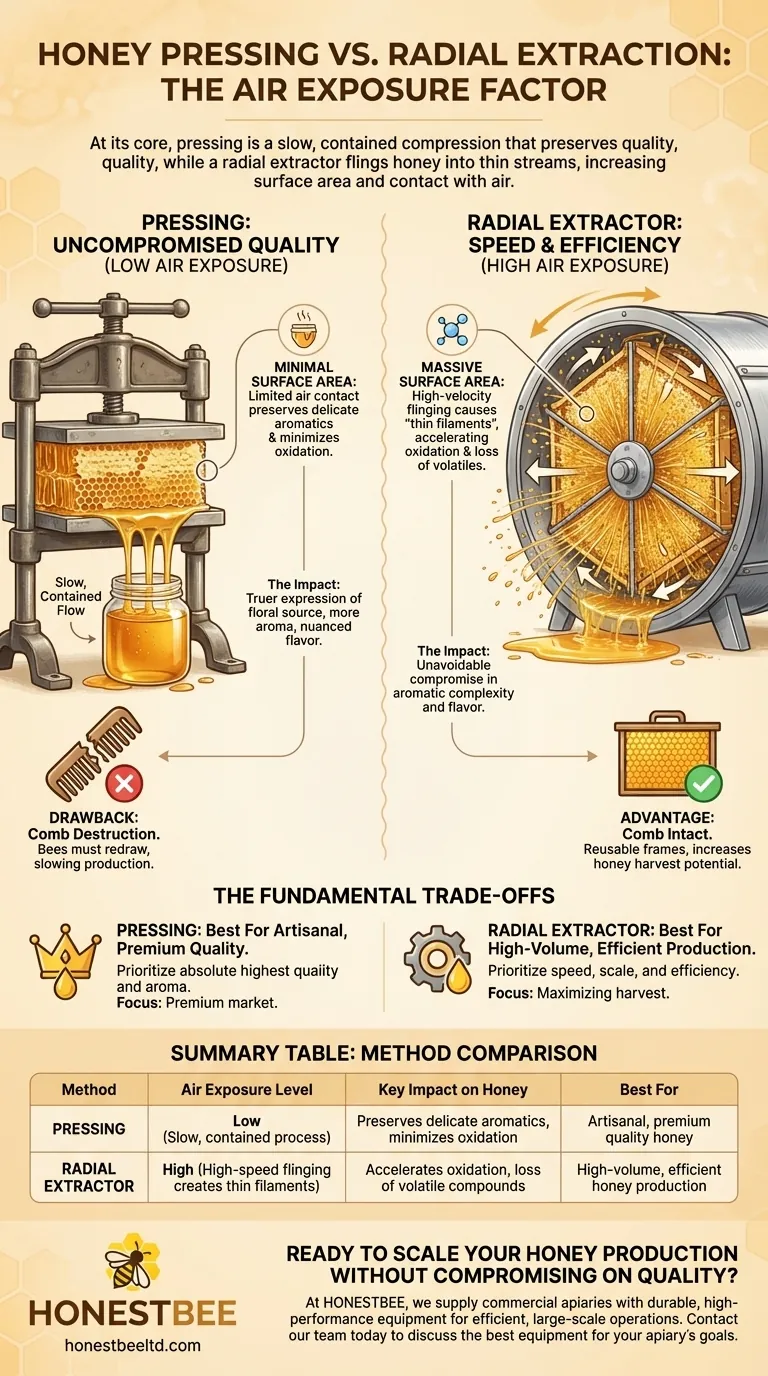At its core, pressing honey reduces air exposure by being a slow, contained compression process, whereas a radial extractor slings honey out in thin streams, dramatically increasing its surface area and contact with air. This high-velocity flinging action accelerates oxidation and causes the loss of delicate aromatic compounds, which pressing largely avoids.
The choice between pressing and extraction is a fundamental trade-off. You are not just choosing a tool; you are choosing between prioritizing the absolute highest quality and aroma of the honey versus the speed, scale, and efficiency of your operation.

The Mechanics of Air Exposure in Extraction
To understand the difference in quality, you must first understand the physics of each method. A radial extractor is designed for speed, but this speed has chemical consequences.
How a Radial Extractor Works
A radial extractor operates on the principle of centrifugal force. Honey frames are positioned vertically like the spokes of a wheel.
As the extractor spins at high speed, the honey is flung outward from the cells, hitting the inner wall of the extractor drum.
The Problem of "Thin Filaments"
The critical issue is how the honey travels. It doesn't exit the comb in a single mass. Instead, it is forced out as countless thin filaments or even a fine spray.
This process dramatically increases the surface-area-to-volume ratio of the honey. Each tiny droplet or thin stream is surrounded by air.
The Chemical Impact: Oxidation and Volatiles
This massive increase in air exposure has two primary negative effects.
First, it leads to oxidation. Oxygen in the air reacts with enzymes and other compounds in the honey, which can subtly alter its flavor and darken its color over time.
Second, it causes the loss of volatile aromatics. These are the delicate, light molecules that give different honey varieties their unique floral scents and flavors. When exposed to air in thin streams, they simply evaporate, leaving a less complex final product.
How Pressing Preserves Quality
A honey press operates on a completely different principle: slow, mechanical force. This method prioritizes preservation over speed.
The Pressing Process
In a press, uncapped honeycomb (often cut from the frame) is placed in a container with a perforated base. A press plate then slowly applies immense pressure.
This pressure squeezes the honey out of the wax cells, allowing it to flow down into a collection vessel.
Minimizing Surface Area
Unlike extraction, pressing forces the honey out in a more cohesive, thicker mass. It is not atomized into a spray or stretched into thin filaments.
The honey's exposure to air is limited to the surface of this slow-moving mass. This keeps oxidation and the loss of volatile compounds to an absolute minimum, preserving the honey's most fragile characteristics.
Understanding the Trade-offs
Neither method is universally "better"; they serve different goals and come with significant, opposing consequences.
The Case for Pressing: Uncompromised Quality
The primary advantage of pressing is the superior quality of the final product. The resulting honey is a truer expression of its floral source, with more aroma and nuanced flavor intact.
The Drawback of Pressing: Comb Destruction
The most significant disadvantage is that pressing destroys the wax comb. This is a major cost to the bees, who must expend significant energy and resources (consuming pounds of honey) to redraw all new comb. This slows down the colony's overall honey production.
The Case for Extraction: Speed and Efficiency
The clear advantage of a radial extractor is its efficiency. It can process a large number of frames quickly and, crucially, it leaves the drawn comb intact.
Frames can be returned directly to the hive for the bees to refill, saving them an enormous amount of work and dramatically increasing the potential honey harvest for the season.
The Drawback of Extraction: Quality Compromise
The efficiency of extraction comes at a price. While the honey is still excellent, there is an unavoidable compromise in its aromatic complexity and a greater potential for oxidation due to the mechanics of the process.
Making the Right Choice for Your Goal
Your decision should be guided entirely by your primary objective as a beekeeper.
- If your primary focus is producing the highest-quality artisanal honey for a premium market: Pressing is the superior method as it best preserves the delicate flavors and aromas.
- If your primary focus is maximizing your honey harvest and operational efficiency: A radial extractor is the definitive choice because it is fast and allows you to reuse the comb.
Understanding this core trade-off between quality and efficiency empowers you to choose the extraction method that perfectly aligns with your beekeeping philosophy.
Summary Table:
| Method | Air Exposure Level | Key Impact on Honey | Best For |
|---|---|---|---|
| Pressing | Low (Slow, contained process) | Preserves delicate aromatics, minimizes oxidation | Artisanal, premium quality honey |
| Radial Extractor | High (High-speed flinging creates thin filaments) | Accelerates oxidation, loss of volatile compounds | High-volume, efficient honey production |
Ready to scale your honey production without compromising on quality?
At HONESTBEE, we supply commercial apiaries and beekeeping equipment distributors with the durable, high-performance extraction and processing equipment needed for efficient, large-scale operations. Our wholesale-focused solutions help you maximize your harvest while maintaining the standards your customers expect.
Contact our team today to discuss the best equipment for your apiary's goals.
Visual Guide

Related Products
- HONESTBEE 72 Frame Industrial Electric Honey Extractor for Beekeeping
- 6 Frame Manual Stainless Steel Honey Extractor Beekeeping Equipment
- 8-Frame Electric Self-Reversing Honey Extractor Spinner for Commercial Honey Extraction Equipment
- HONESTBEE 3-Frame Manual Acrylic Honey Extractor
- HONESTBEE 8 Frame Electric and Manual Three Use Honey Extractor
People Also Ask
- What is the energy consumption like for automatic honey extractors? Maximize Your Harvest Efficiency
- Why is preserving honeycomb integrity important, and how do automated extractors help? Boost Hive Health & Honey Yields
- Why do beekeepers have to lift a lot of weight at the end of a growing season? The Reward of a Heavy Harvest
- How is honey harvested from Langstroth hives? A Guide to Efficient, Comb-Preserving Extraction
- How do automatic honey extractors function? Achieve High-Efficiency Honey Harvesting



















